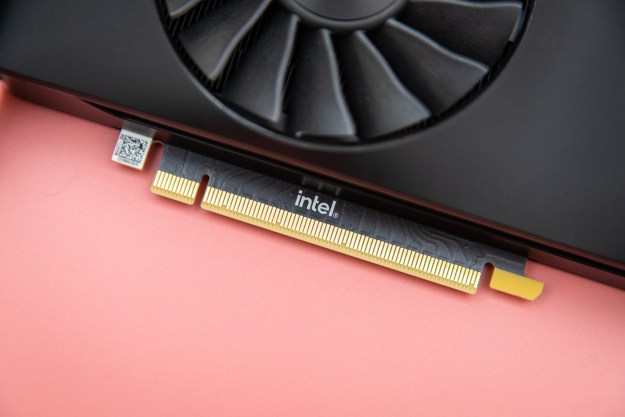The upcoming Intel Arc Alchemist gaming graphics card was spotted in an Ashes of the Singularity benchmark.
Intel’s first discrete gaming GPU managed to maintain consistently high frame rates in the test.

The card appeared in a benchmark posted on the official website for Ashes of the Singularity. It appears to be a dedicated graphics card based on the Xe-HPG DG2 GPU. Although the benchmark doesn’t specify that this is an Intel Arc Alchemist card, it’s easy to deduce — integrated Intel Xe graphics don’t offer the kind of performance this card managed to pull off.
Paired with Intel’s latest-and-greatest Intel Core i9-12900K processor, the card held up well, maintaining an average of 126.9 frames per second (fps). The preset used suggests that medium graphic settings were used and the game was being played at 1080p.
As this is a demo sample being tested ahead of time, it’s difficult to accurately compare that score to graphics cards offered by Nvidia and Intel. The result was similar to that of an RTX 3080 Ti, but that may not reflect the real expected performance of the graphics card. Ashes of the Singularity benchmarks are also not the most reliable way to measure a card’s performance, but the fact remains that it maintained a rather high fps rate.
Intel Arc Alchemist is going to be Intel’s first line of gaming graphics cards. Although it can’t be expected to outperform the best GPUs on the market, it should find its way into many gaming PCs. Specifications of the card put it in line with Nvidia’s RTX 30-series cards. Intel may not be releasing a competitor to the RTX 3090 just yet, but the top variant may be comparable to the RTX 3070.

Over the last few months, many leaks regarding the cards have been spotted, allowing us to learn more about their specifications. The top variant is expected to come in at least three different configurations, starting with the high-end Alchemist with 512 execution units (EUs), 4,096 cores, 16GB of GDDR6 memory, and a 256-bit bus. The memory bandwidth is rumored to be at either 16Gbps or 18Gbps. Rumors point to a clock of around 2.2 to 2.5GHz, but Intel hasn’t revealed the official specifications just yet.
Aside from the highest configuration, rumors point to a variant with 384 EUs, 3,072 cores, and 12GB of memory, running on a 192-bit bus. There may also be a GPU with 256 EUs, 2,048 cores, 8GB of GDDR6 memory, and a 128-bit bus.
All of the cards are expected to consume rather high amounts of power. Intel made the choice to create competitive gaming graphics cards, but the jump in performance definitely comes at a price. The top 512 EU Alchemist card is rumored to have a TDP of 225 watts to 275 watts.
While the Arc Alchemist branding was already announced through a dazzling light show, Intel is supposed to fully unveil the upcoming graphics cards during CES 2022 in January. Desktop units are likely to hit the shelves in February, but laptop users may have to wait for months before trying out an Intel Arc Alchemist GPU.
Editors' Recommendations
- Intel Battlemage graphics cards: release date speculation, price, specs, and more
- Nvidia RTX 50-series graphics cards: news, release date, price, and more
- Intel may be throwing away an important opportunity
- Intel may already be conceding its fight against Nvidia
- Intel’s forgotten GPUs are still happening




